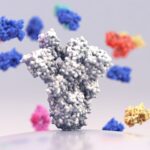
Source: Viaframe/Getty Image
When faced with the same evidence, each individual can reach a different decision. How billions of specialized cells make split-second choices has largely been an open research question.
In a new study published in Nature titled, “The dynamics and geometry of choice in the premotor cortex,” researchers from Princeton University, in collaboration with Cold Spring Harbor Laboratory, Stanford University, and Boston University, demonstrated the existence of a neuron population code for the dynamics of choice formation in the primate premotor cortex.
The research team trained rhesus macaques to determine which color, red or green, was more dominant on a checkered screen. The trials included a mix of clear-cut decisions and ambiguous choices that required deliberation. The researchers recorded the activity from nerve cells in the dorsal premotor cortex, a brain region involved in translating decisions into actions, and found that neurons displayed a high degree of heterogeneity even within the same trial.
“The widespread assumption is that this heterogeneity reflects the complex dynamics involved in cognition,” said Tatiana Engel, PhD, associate professor at the Princeton Neuroscience Institute and the corresponding author of the study. “But surprisingly, we found that this apparent complexity arises from a very different neural coding principle.”
Classic experiments in neuroscience have shown that the brain has predictable approaches to map simple sensory information, such as basic shapes or sounds. However, more complex decisions that are tied to actions have been historically challenging to elucidate.
Instead of relying on a single neuron, the nervous system uses the pattern of activity across many neurons to encode information, known as a population code. Tuning curves of single neurons for sensory variables determine the geometry of the population code.
The authors developed a flexible computational model that revealed two critical features driving neuron behavior. The first is tuning, or when and to what kind of decision a neuron tends to respond. The second is neural dynamics, represented by a “potential landscape” that guides activity.
The model showed that while tuning remained consistent across trials, the shape of the potential landscape varied. In easier tasks, the landscape was steep, leading to quicker, more confident decisions. In more difficult tasks, the terrain was flatter and more susceptible to noise, increasing the chances of mistakes. Though each neuron had a different individual response, they all shared the same underlying potential landscape.
“Think of it like a group of skiers descending a mountain,” Engel said. “Each prefers a slightly different path, but all are shaped by the same slope beneath them. Similarly, each neuron has its own preference and activity, but the group of cells collectively in the premotor cortex takes a coordinated journey and gradually settles into a stable state that represents the decision.”
Taken together, understanding how neurons collaborate to make decisions can shed light on fundamental brain function and disorders such as schizophrenia or bipolar disorder, where decision-making processes are altered. Looking ahead, the authors plan to investigate how different types of neurons and their interactions contribute to the diverse tuning and distinct phases of decision-making observed in this study.



